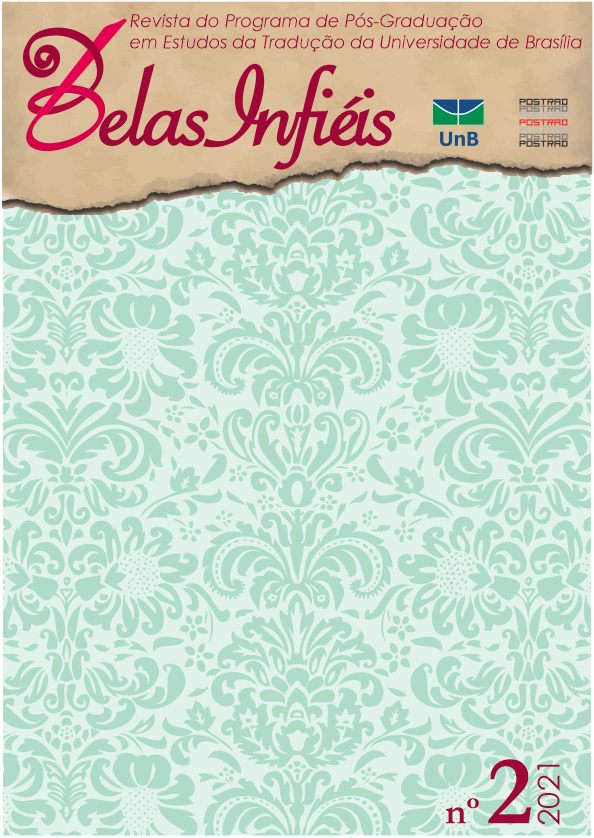A formação de tradutores na extensão universitária: a prática da tradução literária
DOI:
https://doi.org/10.26512/belasinfieis.v10.n2.2021.32721Palabras clave:
Educação e treinamento. Literatura. Retradução. Didática da tradução. Tarefa.Resumen
O projeto de extensão “Formação de Tradutores: Prática da Tradução Literária” (FORTRALIT) teve início em 2017 na Universidade do Estado do Rio de Janeiro (UERJ), buscando contemplar a experiência da tradução literária via duas ações principais: a tradução e/ou versão de relatos escritos por tradutores (literários) profissionais cujo tema deve ser a própria prática, e a retradução de textos literários. O artigo pretende apresentar o projeto FORTRALIT, expor brevemente algumas das atividades desenvolvidas no âmbito do projeto em geral, detalhar uma tarefa conduzida no âmbito do par linguístico português/inglês, por estagiários alunos do curso de Letras, habilitação Inglês/Literaturas e apresentar a visão de uma das estagiárias desta habilitação. A base pedagógica do projeto FORTRALIT engloba discussões acerca da formação de tradutores e tradutoras bem como a visão do projeto sobre a retradução e sobre seu uso para o ensino da tradução literária. O projeto foi concebido para seguir a didática da tradução tal como preconizada por Hurtado Albir (2005, 2020), isto é, partindo do desenvolvimento de (sub)competências tradutórias dos aprendizes, tendo por base o enfoque por tarefas. No âmbito do FORTRALIT foi escolhida, nesses primeiros anos de atividade, a tarefa da retradução (exercício de leitura, velada ou propriamente dita) como o instrumento capaz de oferecer ao mesmo tempo uma reflexão sobre a “incompletude” inerente ao processo tradutório - ao se comparar várias traduções, por exemplo – e um exercício prático de tradução seguido de reflexão e discussão a partir da comparação com modelos que seriam “canônicos”. Os resultados apontam para a visão de uma retradução relevante, possível entre as tantas outras possíveis.
Descargas
Citas
ALVES, F.; MAGALHÃES, C.; PAGANO, A.. Traduzir com autonomia. Estratégias para o tradutor em formação. São Paulo: Editora Contexto, 2000.
ANTUNES, M. A. G. Um estudo sobre feedback escrito em redações de aprendizes de inglês como língua estrangeira. 1994. Dissertação (Mestrado em Linguística Aplicada) ”“ Faculdade de Letras, Universidade Federal do Rio de Janeiro, Rio de Janeiro, 1994.
ANTUNES, M.A.G.; PESSOA, D. Diferenças e singularidades. Pesquisa em tradução no Instituto de Letras da UERJ. Rio de Janeiro: Dialogarts, 2018.
DA SILVA, I. A. L.; ESQUEDA, M. D.; JESUS, S. M. DE. Em busca de ideários didáticos nos Estudos da Tradução. Letras & Letras, v. 32, n. 1, p. 7-19, 5 set. 2016.
EVANS, J. Translation as a critical practice: using retranslation when teaching translation. Quaderns, Revista de Traducció, v. 21, p. 199-209, 2014.
FROTA, M. P. Erros e lapsos de tradução: um tema para o ensino, Cadernos de Tradução, v. 1, n. 17, p. 141-156, 2006.
GONÇALVES, J. L. V. R.. Repensando o desenvolvimento da competência tradutória e suas implicações para a formação do tradutor. Revista Graphos, UFPB/PPGL, v. 17, n. 1, p. 114-130, 2015.
HURTADO ALBIR, A.; GOMES, L. T.; DANTAS, M. P.. Competência tradutória e formação por competências. Cadernos de Tradução, Florianópolis, v. 40, n. 1, p. 367-416, jan. 2020. Disponível em: <https://periodicos.ufsc.br/index.php/traducao/article/view/2175-7968.2020v40n1p367>. Acesso em: 08 mar. 2020.
HURTADO ALBIR, A. A Aquisição da competência tradutória: aspectos teóricos e didáticos. In: ALVES, F.; MAGALHÃES, C., PAGANO, A. (orgs.) Competência em tradução: cognição e discurso. Belo Horizonte, MG: Editora da UFMG, 2005. p. 19-57.
RICHARDS J. C.; SCHMIDT, R.. Longman Dictionary of Language Teaching and Applied Linguistics. London: Pearson, 2010.
SCHÄFFNER, C; ADAB, B. (eds.). Developing translation competence. Amsterdam: John
Benjamins Publishing, 2000.
Descargas
Publicado
Cómo citar
Número
Sección
Licencia
Derechos de autor 2021 CC BY

Esta obra está bajo una licencia internacional Creative Commons Atribución 4.0.
Copyright Statement
Given the public access to this journal, the texts are free to use but requires the recognition of the original authorship and initial publication in this journal to be properly stated.
The journal allows the use of works published for non-commercial purposes, including the right to submit the work to publicly accessible databases. Published contributions are the sole and exclusive responsibility of the author(s).
- When submitting papers to be evaluated by the Belas Infiéis journal, the author(s):
- Declare that the contents of the contributions are original and of their original creation, being entirely responsible for their content if there is an objection by third parties.
- Claim to be aware that they should not commit academic plagiarism.
- Declare that the manuscript has not been published, completely or partially, in Portuguese or another language. If it is a translation it should be submitted to the Translated Articles section.
- Declare that the manuscript is not being evaluated by other journals.
- Declare that the manuscript was not submitted to another journal simultaneously.
- Commit(s) to inform the journal of any kind of error or inaccuracy in their contribution (published, in evaluation or in editing) and to collaborate with the editors to make due corrections of the article (when in evaluation or editing) or erratum/retraction (after publication).
- Declare that there is no conflict of interest regarding the published work.
- Authorize its release if it is accepted for publication without any kind of monetary compensation.
- Agree to assign non-exclusive rights to publication to the magazine, remaining free to make their contribution available in other media as long as the publication of the first version in Belas Infiéis magazine is mentioned. They also authorize Belas Infiéis to assign their texts for reproduction in content indexers, virtual libraries and similar platforms.
- Maintain copyright and grant the journal the right of first publication, the work being licensed under theCreative Commons Attribution License.
- Is/Are allowed and encouraged to publish and distribute their work online after the editorial process, which may increase the impact and citation of the published work.
- Authorize the editorial team to make textual adjustments and to adapt the article to the publication rules, when necessary.



















